NVIDIA’s GeForce GT 240: The Card That Doesn't Matter
by Ryan Smith on January 6, 2010 12:00 AM EST- Posted in
- GPUs
Power, Temperature, & Noise
With an idle power draw of 9W, and a load power draw of only 70W, the GT 240 should fare fairly well here. As an added bonus, with the significantly different designs of the Asus and EVGA cards, we have a chance to see the difference in performance for their respective coolers.
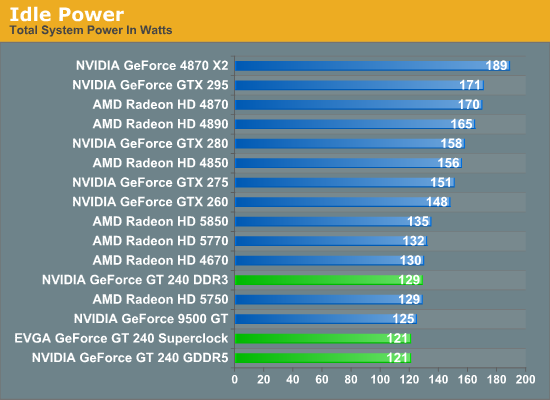
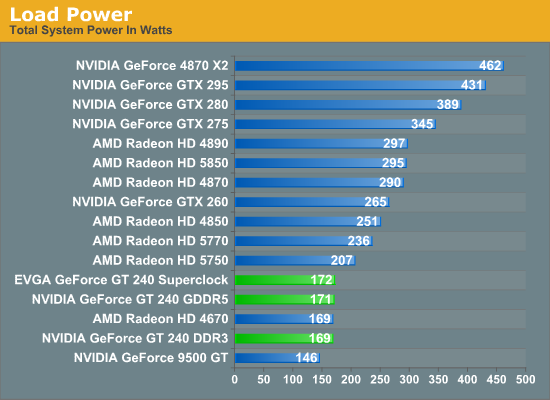
Due to some unrelated issues we don’t have the GT 220 in these charts, leaving the GDDR5 GT 240 as our least power-hungry card when it comes to idling. Unfortunately our DDR3 GT 240 refused to (or is simply not programmed to) idle, meaning that it comes in a good 8W higher than the GDDR5 versions of the cards. The lack of true idling for the DDR3 card will have some ramifications later.
Under load, these cards are still near the top of our charts. The only thing that’s significantly lower is the otherwise anemic 9500 GT while the Radeon 4670 is in a dead-heat. Between the GT 240 cards themselves, even with the different in RAM types, they’re all within 2W of each other. These would probably make fair HTPC cards, but the GT 220 should be a bit less power hungry and cooler.

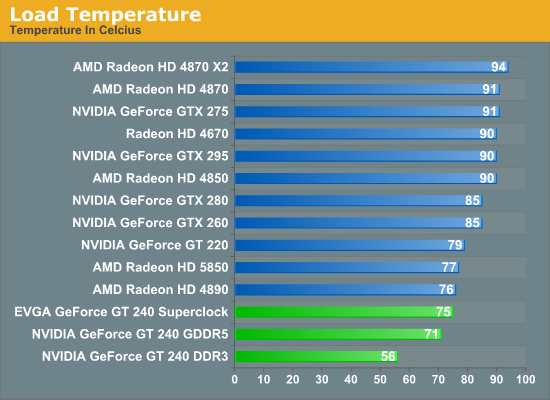
All of these cards push the limits of what’s practical for idle temperatures, although the Radeon 5850 is finally dethroned here by 2 of our GT 240 cards. The double-wide cooler on the Asus cards looks to be good for a couple more degrees than the single-wide cooler on the EVGA card is.
Load temperatures tell us a somewhat different story however. Ignoring the DDR3 card for a second, both the Asus and EVGA cards are quite cool. Our stock Asus card is some 8C cooler than our GT 220, and 19C cooler than the Radeon 4670. The EVGA card meanwhile is 4C cooler than the GT 220, and still 15C cooler than the 4670 in spite of the use of similar single-slot coolers. For what the GT 240 lacks in performance, it can certainly make up for in temperatures.
As for the DDR3 card, in spite of having the same cooler Asus has opted to run the fan at a higher speed. This makes it cooler, but as we’ll see it makes it louder too.
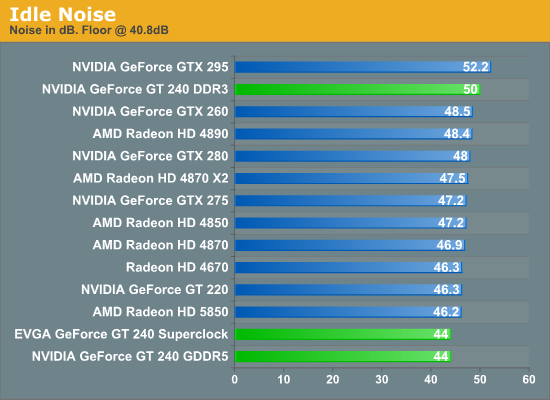
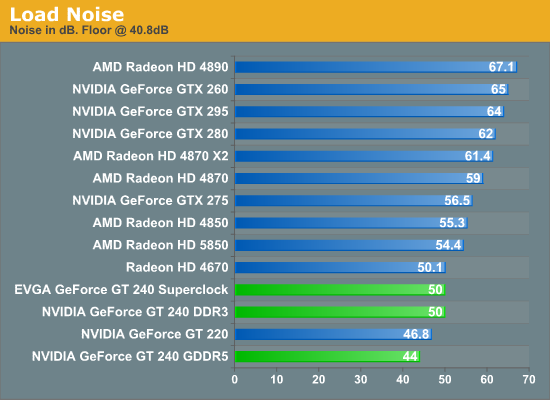
At idle, there’s not much of a story for the GDDR5 cards. They all run up against the ambient noise generated by the rest of the computer. Active and passively cooled cards are nearly indistinguishable at this point. The Asus DDR3 card however is quite distinguishable and is at the bottom of our charts. Its higher fan speeds means that it even idles at a pretty high speed, making it the second-loudest thing after the GTX 295.
It’s under load that the story takes a turn for the most interesting. At 50dB is the Asus DDR3 card and the EVGA card – the former continuing to use its high fan speeds, and the latter having to rev up to make up for its smaller single-slot cooler. Even at 50dB, these cards are quieter than everything besides the otherwise lower-powered GT 220.
Meanwhile down at 44dB is the Asus GDDR5 card, generating the same amount of noise as if it were idling. Based on these results, the card is for all practical purposes indistinguishable from a passively cooled card. Through the combination of a large fan and a large heatsink, the amount of noise the card generates falls below the ambient noise of the rest of the computer. The card is effectively silent.
Now we suspect that if we had a rig specifically for testing silent cards we would find a more notable difference, but in our i7 920 rig there is none to be found. The Asus GT 240 GDDR5 is the quietest actively cooled card we have tested to date, something we were not expecting to find on a GT 240 card. Also bear in mind that this the second-coolest card we have ever tested, falling behind only our overly loud DDR3 card. In the future, someone is probably going to make a very nice fully-passive card out of the GT 240 if all of this can be accomplished with the Asus cooler.










55 Comments
View All Comments
BernardP - Thursday, January 7, 2010 - link
Despite the fact that it *is* overpriced, I bought the Asus GT240 DDR5. Why? It fits in my small case while the "green" 9600GT and 9800GT don't. It has "good enough" performance for the light gamer that I am. It is a well-balanced match with my Athlon 64 X2 5400+. I'm staying with my current build and Win XP for the next 2 years, so DX10 or DX11 is not important. It's a near-silent HTPC card, my main use. I favor NVidia drivers, especially their ability to create and scale custom resolutions. Why has ATI still not included this feature in their catalyst driver? I don't want to fiddle with PowerStrip.With a bit of fine tuning of the fan speed profile in the Asus SmartDoctor utility, I'm able to keep GPU temps below 56 deg. Celcius while gaming, with little added noise. At idle, the card temp is hovering around 33-34 deg.
Overall, I am very satisfied with my Asus GT240 GDDR5
knowom - Wednesday, January 6, 2010 - link
I really like the low power, heat, and noise on the GT 240 a good fanless one would make a excellent HTPC/DAW candidate. A follow up review underclocking it and comparing it against a 9600GT and a bunch of integrated graphics and perhaps I5 as well.philologos - Wednesday, January 6, 2010 - link
I have an aging Dell Dimension E510, for which I bought a Zotac GT240 512MB GDDR5 AMP! edition. I needed a single slot card with very little height, and I also was wary of using the 6-pin connector from my Dynex (aka Be$t Buy) 400w PSU. I really wanted a 5770, but the coolers would have interfered with Dell's CPU cooling "tunnel."I agree the price should be dropped ten to twenty dollars, but there's been a massive improvement from the 8500GT that it replaced. This should tide me over until can afford my first home-built. The GT240 might even serve as a PhysX processor if such things don't go the way of the dinosaurs. Basically, I think this card has a definite niche; I didn't look at the 9800GT Greens, unfortunately, but I have doubts one would even fit. There is precious little space for expansion cards in my 'puter.
BelardA - Thursday, January 7, 2010 - link
The 9800GT should fit... even some versions of the ATI 4850.Dynex PSUs are usually not that good... :(
Check out the 12v rail requirements of the video card, but then again - the GT240 (stupid names) is in the same power class as the ATI 4600s.
Yeah, some people have to bend some metal to make PSUs and cards fit in the Dell E510.
asusmaun - Wednesday, January 6, 2010 - link
Hi! I think the GT 240 models with GDDR5 are extremely sweet and I want to get one. I recommend it!Look at the fine features:
* Low power / cool temps (69W)
* Quiet
* Small card (eVGA's card is even 1 slot)
* Pure Video 4th and 5th generation (VP4/5). This might be the only card that does VP5 stuff right now.
* Plays most games fine if quality/res not set too high. This is true, more or less, for all graphics cards at some point. You can never keep up with game graphics demands without spending a lot of money. If you can spend that much money, good for you, but many cannot.
* Affordable price for a card with new technology
The next Nvidia model up, the GTS 250 is a huge, hot (145W) card that is old technology dressed up with a new model name (again!). It only can do Pure Video 2nd generation (VP2) video acceleration. Sure, it can play games a little faster, but game performance isn't always the lone recommend factor for choosing your card. And, the GTS 250 does cost more when I looked at prices. If the GT 240 has enough game performance for you right now, then the GTS 250 is not a better card.
I'm not going to talk about Radeon cards because I run on Linux and stay with Nvidia cards. If you are going Nvidia, the GT 240 is in the sweet spot for overall price/performance/features IMO.
If the GT 240 is good enough for you now, the price is maybe low enough also that by the time it seems too slow for you, there will be much better cards with new technology for you to upgrade to later.
To say the card doesn't matter and just not recommend it based on mainly game performance, isn't really looking at this card's features and market from a balanced point of view. The card could be highly recommendable for a computer used for watching movies and some game playing (HTPC or others). This card is just never going to please those kinds of users that are spoiled with the highest-end components all the time - the rest of us have to compromise some and the GT 240 can fit budget and purpose well right now.
This review article, even though it does not recommend the card, might actually cause a lot of people to rush to buy these cards, for fear they will be discontinued! I was actually impressed with the game performance charts. So, this review article may very well still help sell a lot of these cards. :)
AznBoi36 - Wednesday, January 6, 2010 - link
Excellent points all around.I could see the GT240 as a viable upgrade for those on aging systems (Socket 939/478) and are on a tight budget. Why because the CPUs for those platforms most likely aren't fast enough to power many of the newer mainstream cards (ie: keeping the GPU well fed without being CPU limited). Also these users most likely have older monitors @ 1280x1024, and as shown the GT240 has enough oomph to run many of the new games at 1280x1024 with maximum detail and probably some AA/AF.
New build? I can see this possibly going into a HTPC, but not anything else. There's much better cards out there. The 4670 is the better card overall for HTPC and light gaming IMO. Lower price, similar power requirements, heat and noise.
Hauk - Wednesday, January 6, 2010 - link
Man that article title.. ouch! ;)Spoelie - Thursday, January 7, 2010 - link
It's actually the *message* NVIDIA sent out itself. Not even bothering to send review samples, you're telling the world these cards are low-key and unimportant in the grand scheme of things.Taft12 - Wednesday, January 6, 2010 - link
"I hesitate to call the GT 240 a “bad” GPU"You may hesitate but this review clearly shows that the GT240 paired with DDR3 memory indeed makes for bad GPU. NVidia should have mandated OEMs use DDR5.
DominionSeraph - Wednesday, January 6, 2010 - link
Your usage of "GPU" shows that you have no idea what one is.You probably think the "CPU" is the case.